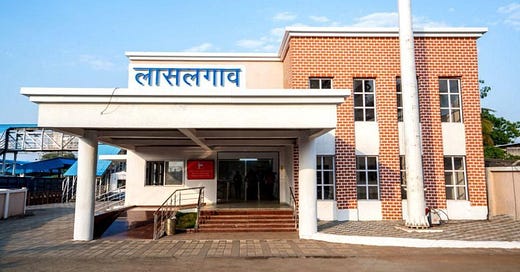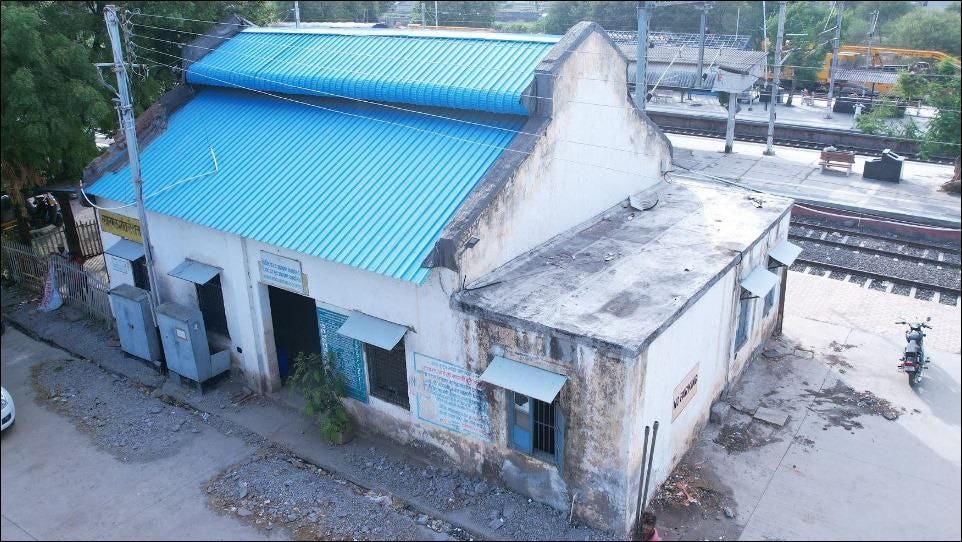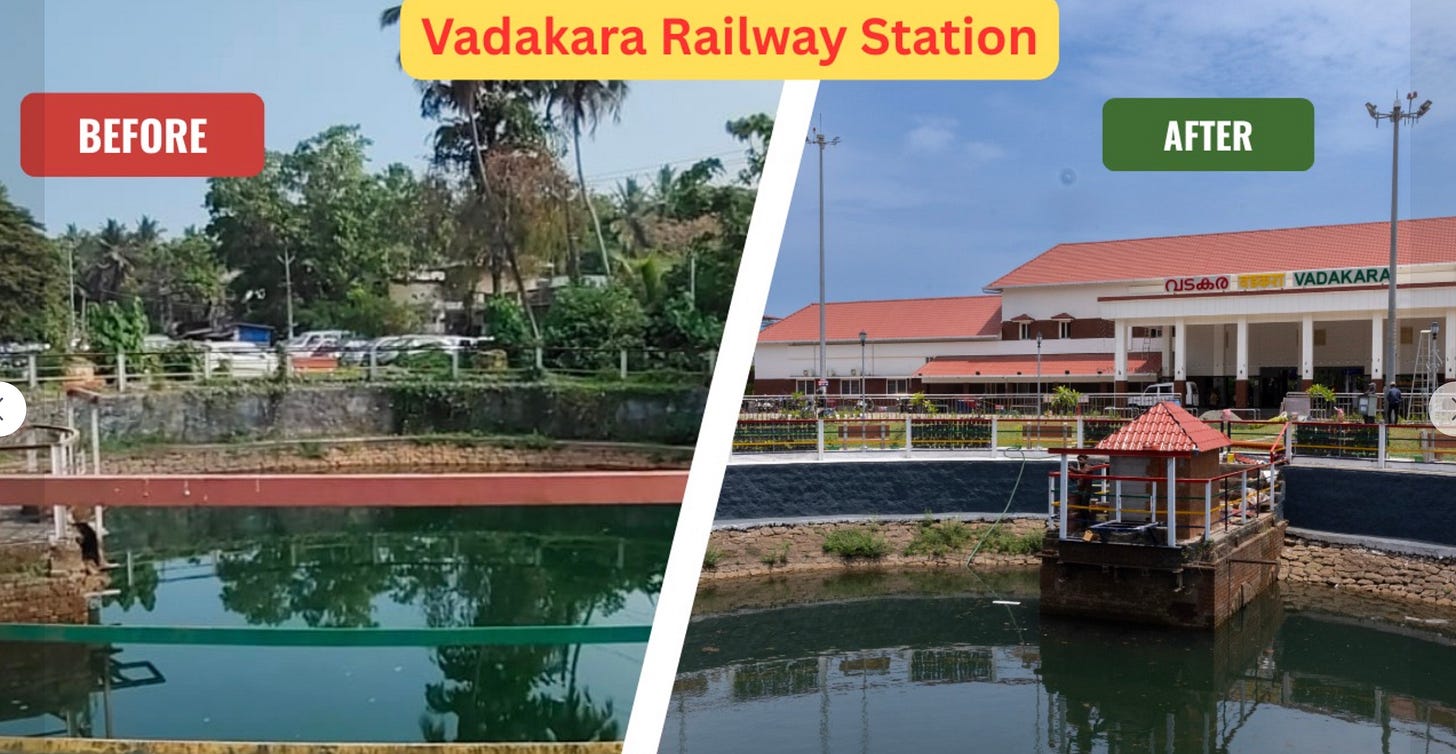Democratising The Indian Railways
Like the Maruti 800 made driving accessible to millions, revamped stations are making train travel more comfortable and inclusive for passengers. EPISODE #227
Dear Reader,
A very happy Monday to you.
Last week, Prime Minister Narendra Modi inaugurated 103 Amrit Bharat stations spread over 18 states across the country. It was part of the Amrit Bharat Station Scheme to make stations more cleaner, comfortable, and easier to access and use.
On the face of it, given our experience of the state of most railway stations in the country, this is yet another audacious ambition from a country determined to chart a new path for its rapidly growing economy.
At another level, this, along with other projects like Vande Bharat, seeks to democratise rail travel—the focus of this week’s newsletter. Just like the small Maruti 800 car did 40 years ago to driving. It democratised access to driving and launched the automobile revolution.
Remember, on an average 23 million passengers—more than the population of some countries—use the Indian Railways every day. Indeed, democratising rail travel will be on par with the country’s recent effort in lifting 41.5 crore people out of poverty.
The cover picture is of the Lasalgaon station, after its makeover. It has been sourced from the union government.
Happy reading.
The Makeover
Till 22 May, Lasalgaon, located in Nashik district, Maharashtra, was known only for its singular investment in growing onions—99% of the agricultural land is devoted to its farming. Not any longer.
This Census Town—a village exhibiting urban characteristics—has a new calling card: A swank railway station. It is now part of a growing list of stations undergoing a makeover to not only make train travel more comfortable and inclusive, but also a means to rejuvenate and monetise the massive railway infrastructure.
If the cover picture above captures the new, the photograph below of a decrepit building, a typical sight across India, is the past—a metaphor for the not so glorious economic history of India.
Sharing a similar makeover of Sihor, a town in Bhavnagar, Gujarat. below.
Before:
…and after:
And another of Amgaon, a town located in Gondia district of Nagpur, Maharashtra.
Before:
…and after:
The thing is that, this is not just about providing a new facade.
For one, it is a break from a long neglected past. Most stations, even in the metros, have rarely got the attention they deserve. Worse, most of them are surviving from the colonial era and hence desperate for a makeover.
Second, the growing footfalls has made this makeover imperative. Like I said in the introduction, daily passenger traffic is huge. Annually their count is staggering: measuring 715 crore in 2024-25. In some instances, this has led to avoidable human tragedies with the dilapidated infrastructure unable to take the load.
Thirdly, these massive footfalls could be turned into an advantage. They provide the perfect spot to create a hub that can do much more than just being an entry and exit point for passengers. This kind of a makeover provides the perfect blueprint to unlock the potential of the vast real estate owned by the Indian Railways.
Pull all these strands together and you have a new era for railway infrastructure.
Amrit Bharat Stations
Last week Prime Minister Narendra Modi inaugurated 103 revamped stations across the country. The graphic above, sourced from the Press Information Bureau, captures the distribution of the stations. This makeover has a moniker: Amrit Bharat Stations Mission.
The Railway Land Development Authority (RLDA), which has been tasked to lead this makeover, has the following mission objective:
“The redevelopment of railway stations provides an opportunity to not only modernise transportation infrastructure but also create vibrant, sustainable, and interconnected urban centres.”
The state of railway stations, even a decade ago, would never have realised this objective. I am sure you too can share an anecdotal experience of tough train journies. Growing up, I have experienced stations across India.
Annually, our family would embark on their journey from New Delhi to Vatakara, Kerala. This journey of nearly 1,000 km, undertaken on hard wooden bunks softened by the beddings we carried, would take us four days. At that time, North Kerala did not enjoy the connectivity it did today. As a result, we had to disembark in Chennai, and board another train to reach Palghat, inevitably around 2 or 3 am on the fourth day.
We had to wait for our connecting local passenger train to Vadakara, in a decrepit waiting room where bed bugs had a free run of our sleepy and tired bodies. It would be several hours more before we ended what would have been an ordeal for our parents—adventure for us kids.
Vadakara, then had a token platform, which people boarded and exited from everywhere except the main entrance—a quaint practice.
Happy to share that this is no longer the case. This station too underwent a makeover. Sharing below a before (not the vintage I experienced) and after look, sourced from PIB.
The RLDA has listed the following priorities to define the ongoing makeover of railway stations across the country.
Railway stations as City Centres.
Railway stations as fusion hubs seamlessly integrating both sides of the city.
World Class Passenger Amenities at par with Airports.
Multi-Modal Connectivity: Creation of seamless travel experiences for passengers.
Segregation of Arrival and Departure
Economic Catalyst: Spurring economic growth in the areas surrounding the stations.
State of the art construction technology.
Planned structure and design based on research based model.
Technical enablement for better passenger services and security.
Transit Oriented Development.
Cultural Enrichment: Incorporate cultural and recreational spaces like museums, theatres and art installations.
Employment generation.
Social Contribution.
Commercial cum station model.
Sustainable Development.
Divyang Friendly Amenities
To showcase the local flavours, these stations will also pursue the strategy of ‘One Station, One Product’—provide display and sale outlets to encourage indigenous and specialised products and crafts.
Similarly, the architecture of the redesigned stations will reflect local culture and heritage. For instance, the Ahmedabad station is inspired by the Modhera Sun Temple, while the architecture for Dwarka station is defined by the Dwarkadheesh Temple.
While Gurugram station will carry the IT theme, the Baleshwar station in Odisha will be designed on theme of Jagannath Temple, the redesign of the Kumbhakonam station in Tamil Nadu will have Chola influences. Essentially the huge railway infrastructure will also provide a cultural tapestry—a tribute to the unbelievable diversity of India.
At the same time, there is an acknowledgement of the need to provide creature comforts, the likes that we couldn’t experience growing up. Train travel will no longer be an ordeal. Instead, it can be an experience.
However, the success of this depends on the contribution of a key stakeholder: passengers. The metro rail networks have emerged as islands of excellence with passengers respecting public infrastructure—model behaviour. The thing is that metro rail enjoys a unique ecosystem with controlled entry and exit points, which allow for monitoring—deterring vandalism.
I am not sure this can be replicated for the revamped railway stations. This puts the onus on us passengers, long used to sell-past-the-date infrastructure. Can we rise to the occasion and become a partner in this monumental change? Over to you.
Recommended Viewing
Sharing the latest episode of Capital Calculus. (Please note that Capital Calculus has moved to a new home (stratnewsglobal.tech) within StratNews Global. This relocation will take a bit of getting used to—bear with me.)
If there is one part of the human body that has evaded biological scrutiny it is the brain. It is almost impossible even for modern scan technology to penetrate the skull beyond one millimeter. This is unlike, say the heart, which is another vital organ. This consequently limits the abilities of doctors to understand brain-related ailments like strokes and neurodegeneration, and their cure.
In a global breakthrough bridging this research gap, the Brain Centre in IIT-Madras, has successfully mapped the human foetal brain and publishing the most detailed 3D high-resolution images. They are now poised to release a similar mapping of an adult brain. Even better, India has placed these findings in the global domain.
Not only has this given the country a seat at the global high table on brain cartography, it has provided a path breaking leg-up to ongoing research on the human brain. To understand this momentous achievement and more, I spoke to Professor Mohanasankar Sivaprakasam, Head, Brain Centre, IIT-Madras.
The brilliant professor, unpacked the breakthrough in terms that a layperson like me could comprehend. If I may add, the learnings from the interview were humbling. This conversation is unmissable.
Do watch. Sharing the link below.
Till we meet again next week, stay safe.
Thank You!
Finally, a big shoutout to Premasundaran and everyone else for their informed response, kind appreciation and amplification of last week’s column. Once again, grateful for the conversation initiated by all readers. Gratitude to all those who responded on Twitter (X) and Linkedin.
Unfortunately, Twitter has disabled amplification of Substack links—perils of social media monopolies operating in a walled garden framework. I will be grateful therefore if you could spread the word. Nothing to beat the word of mouth.
Reader participation and amplification is key to growing this newsletter community. And, many thanks to readers who hit the like button😊.










This is a new India with fresh vision being pursued with conviction and determination. India has one of the largest rail networks in the world and easily the highest number of travelers by train. Coupled with this is the innovative strides being made in the indigenous locomotive and railway coach manufacturing within the country. The domestic consumption and added export markets, make the investments in railway stations a very sensible way to address the problem of facilitating the largest population in the world, to commute safely, economically and speedily, through the length and breadth of the country. The wide range of focus of this government, does not cease to amaze me. Excellent share Anil. Always a pleasure to read your articles.
Dear Anil,
As always an amazing write up. Lasalgaon reminds me of our trip to Shirdi two years ago. We were to take the train from Manmad junction to Mumbai, Manmad being an hours drive from Shirdi. On way we were informed that a bridge had fallen and road was blocked therefore no way we could catch the train from Manmad. I googled the train route and saw Lasalgaon as the next station. Took a diversion, cut across fields and reached a beaten down station 'Lasalgaon' well before the train was to arrive. The station was really in a mess, infact disgusting if l may use the word. What a transformation. PM Modi is doing a great job. God bless him and our country. Thanks again for the article👏👏